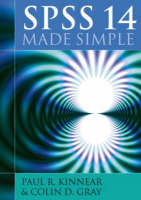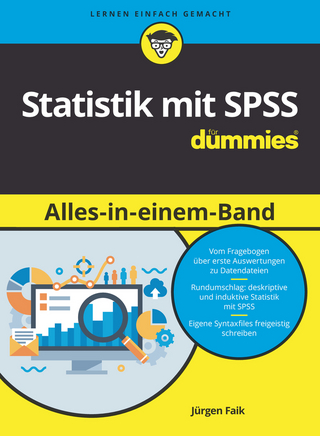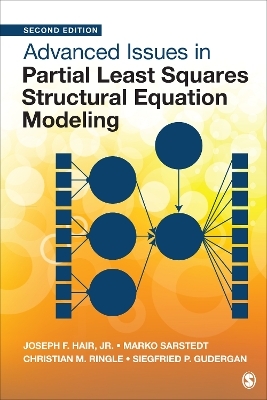
SPSS 14 Made Simple
Psychology Press Ltd (Verlag)
978-1-84169-651-5 (ISBN)
- Titel ist leider vergriffen;
keine Neuauflage - Artikel merken
SPSS 14 Made Simple is the latest edition of one of the most popular textbooks in its field. Each statistical technique is presented in a realistic research context and, as in previous editions, is illustrated with screen snapshots of SPSS dialogue boxes and output. The book provides guidance on the choice of statistical techniques that are right for your research question and your own data, and advises on how to report the results of statistical analysis.
Coverage has been expanded to include several additional topics such as analysis of covariance, partial correlation, multivariate analysis of variance, reliability, signal detection and ROC curves, and Cohen's kappa. Other sections, such as those on power and effect size, have been fully revised and updated. There is also extensive consideration of the new and powerful graphical methods offered by SPSS 14, which are of great assistance at the exploratory stage in data analysis.
The first chapter sets the scene with a survey of different research situations, key terms and advice on the choice of appropriate statistical methods. It provides clear signposts to where each procedure is described in the body of the book. The next chapters introduce you to SPSS and how to use it to get to know your data and graphical methods. Each of the remaining chapters concentrates on one particular kind of research situation and the statistical techniques that are applicable. There are chapters on t-tests, analysis of variance and covariance, correlation and regression, multiway frequency analysis, discriminant analysis, logistic regression and factor analysis. Where appropriate, details of nonparametric tests have also been included.
In summary, SPSS 14 Made Simple:
Shows you how to get the most out of your data
Helps you to choose an appropriate statistical technique
Helps you to avoid pitfalls
Has plentiful screen images of menus and fully annotated dialogue boxes
Shows you how to report the results of your statistical analysis
Includes many exercises, both chapter-specific and more general
Has a comprehensive index
Has a helpful glossary.
Paul Kinnear, formerly Head of the School of Psychology, University of Aberdeen Colin Gray, Senior Lecturer, School of Psychology, University of Aberdeen
Preface.
Chapter 1. Introduction.
1.1 Measurements and Data.
1.2 Experimental Versus Correlational Research.
1.3 Some Statistical Terms and Concepts.
1.4 Choosing a Statistical Test: Some Guidelines.
1.5 One-Sample Tests.
1.6 Finding Latent Variables: Factor Analysis and Canonical Correlation.
1.7 A Final Comment.
Chapter 2. Getting Started with SPSS 14.
2.1 Outline of an SPSS Session.
2.2 Opening SPSS.
2.3 The SPSS Data Editor.
2.4 A Statistical Analysis.
2.5 Closing SPSS.
2.6 Resuming Work on a Saved Data Set.
Chapter 3. Editing and Manipulating Files.
3.1 More about the SPSS Data Editor.
3.2 More on the SPSS Viewer.
3.3 Selecting from and Manipulating Data Files.
3.4 Importing and Exporting Data.
3.5 Printing from SPSS.
Chapter 4. Exploring Your Data.
4.1 Introduction.
4.2 Some Useful Menus.
4.3 Describing Data.
4.4 Manipulation of the Data Set.
Chapter 5. Graphs and Charts.
5.1 Introduction.
5.2 Bar Charts.
5.3 Error Bar Charts.
5.4 Pie Charts.
5.5 Line Graphs.
5.6 Scatterplots and Dot Plots.
5.7 Using Chart Builder and Interactive.
5.8 Receiver-Operating-Characteristic (ROC) Curve.
Chapter 6. Comparing Averages: Two-Sample and One-Sample Tests.
6.1 Overview.
6.2 The T Tests.
6.3 Effect Size, Power and the Number of Participants.
6.4 Other Tests For Comparing Averages.
6.5 One-Sample Tests.
Chapter 7. Introduction to ANOVA: The One-Factor between Subjects Experiment.
7.1 Introduction.
7.2 How the One-Way ANOVA Works.
7.3 Further Analysis.
7.4 The One-Way ANOVA with SPSS.
7.5 Alternatives to the One-Way ANOVA.
Chapter 8. Between Subjects Factorial Experiments.
8.1 Introduction.
8.2 Factorial Analysis of Variance.
8.3 Further Analysis.
8.4 The Two-Way ANOVA with SPSS.
8.5 More Complex Experiments.
8.6 A Final Word.
Chapter 9. Within Subjects Experiments.
9.1 Introduction.
9.2 A One-Factor within Subjects ANOVA.
9.3 Nonparametric Tests for a One-Factor within Subjects Experiment.
9.4 The Two-Factor within Subjects ANOVA.
9.5 A Final Word.
Chapter 10. Mixed Factorial Experiments.
10.1 Introduction.
10.2 The Two-Factor Mixed Factorial ANOVA.
10.3 The Three-Factor Mixed ANOVA.
10.4 Further Analysis: Simple Effects and Multiple Comparisons.
10.5 Multivariate Analysis of Variance (MANOVA).
Chapter 11. Measuring Statistical Association.
11.1 Introduction.
11.2 The Pearson Correlation.
11.3 Correlation with SPSS.
11.4 Other Measures of Association.
11.5 Association in Nominal Data.
11.6 Do Doctors Agree? Cohen’s Kappa.
11.7 Partial Correlation.
11.8 A Final Word.
Chapter 12. Regression.
12.1 Introduction.
12.2 Simple Regression with SPSS.
12.3 Multiple Regression with SPSS.
12.4 Scatterplots and Regression Lines.
12.5 A Final Word.
Chapter 13. Multiway Frequency Analysis.
13.1 Introduction.
13.2 Two Examples of a Loglinear Analysis.
13.3 A Final Word.
Chapter 14. Discriminant Analysis and Logistic Regression.
14.1 Introduction.
14.2 Discriminant Analysis with SPSS.
14.3 Binary Logistic Regression.
14.4 Multinomial Logistic Regression.
14.5 A Final Word.
Chapter 15. Latent Variables: Exploratory Factor Analysis and Canonical Correlation.
15.1 Introduction to Exploratory Factor Analysis.
15.2 A Factor Analysis of Data on Six Variables.
15.3 Using SPSS Syntax.
15.4 Canonical Correlation.
15.5 A Final Word.
Revision Exercises.
Glossary.
References.
Index.
| Erscheint lt. Verlag | 27.7.2006 |
|---|---|
| Verlagsort | Hove |
| Sprache | englisch |
| Maße | 174 x 246 mm |
| Gewicht | 1134 g |
| Themenwelt | Geisteswissenschaften ► Psychologie |
| Mathematik / Informatik ► Mathematik ► Computerprogramme / Computeralgebra | |
| ISBN-10 | 1-84169-651-X / 184169651X |
| ISBN-13 | 978-1-84169-651-5 / 9781841696515 |
| Zustand | Neuware |
| Haben Sie eine Frage zum Produkt? |
aus dem Bereich


